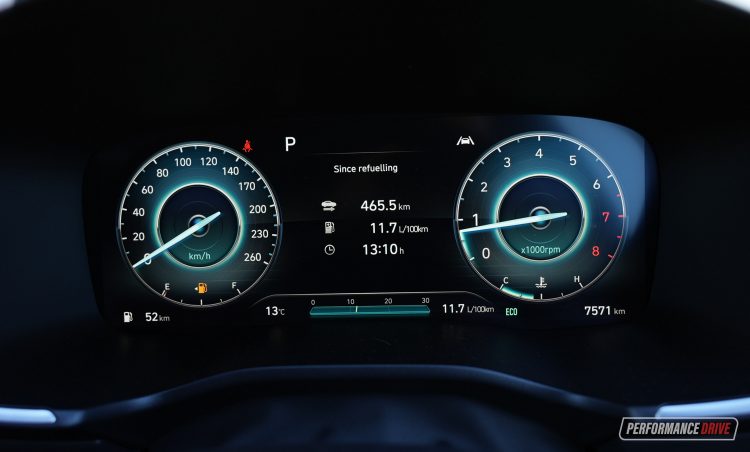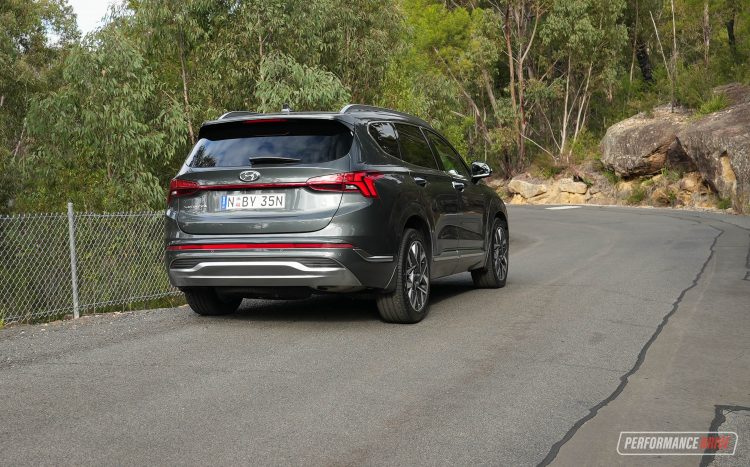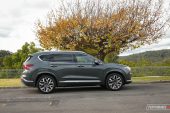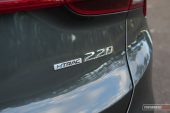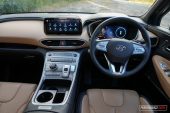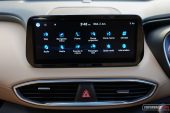Since when did Hyundai become a luxury carmaker? That’s what our first impressions were when we got our hands on the latest Santa Fe. It is now the second-largest SUV in the South Korean manufacturer’s beefed up SUV range. It loggerheads with other 7-seaters like the Toyota Kluger, Mazda CX-9, and it’s cousin, the Kia Sorento.
For MY2021-2022, the Santa Fe has upped the ante in luxury refinements, styling, and technology. With no hybrid option expected until late 2022, it continues with updated versions of the same two engines; an economical 2.2-litre four-cylinder turbo-diesel that powers all fours, and a hefty 3.5L V6 petrol that powers the front wheels only. The diesel also scores a new eight-speed wet twin-clutch auto transmission.
The lineup stays familiar with the base spec Santa Fe, then the Active, the Elite, and at the top, the Highlander. All variants can be chosen with either drivetrains. Here, we’re putting the Highlander under the microscope in both the diesel and V6 choices.
Prices commence at $48,200 for the absolute base model, and peak at $65,200 for the Highlander diesel. The Highlander petrol starts from $61,700 (all excluding on-road costs).
2022 Hyundai Santa Fe Highlander V6 – THE SPECS
[column width=”47%” padding=”6%”]Engine: 3.5-litre V6 petrol
Output: 200kW@6400rpm / 331Nm@5000rpm
Transmission: Eight-speed auto
Drive type: Front-wheel drive
Wheels: F & R: 20×8.5, 255/45
ANCAP: Five stars
Tare weight: 1810kg
Power-to-weight: 9.05:1 (kg:kW)
Official fuel economy: 10.5L/100km
Economy during test: 11.7L/100km
Fuel capacity/Type: 67L/91 RON[/column] [column width=”47%” padding=”0″]Power efficiency: 19.04kW:L/100km
0-60km/h: 4.01 seconds*
0-100km/h: 8.00 seconds*
60-110km/h: 5.27 seconds*
1/4 mile: 15.89 seconds at 149.4km/h*
Max acceleration: 0.696g
100-0km/h braking: 2.89 seconds at 36.62 metres*
Max deceleration: -1.393g
Decibel at idle: 39*
Peak decibel at 60-100km/h: 79*
Priced from: $61,700[/column][end_columns]
2022 Hyundai Santa Fe Highlander 2.2D – THE SPECS
[column width=”47%” padding=”6%”]Engine: 2.2-litre turbo-diesel four-cylinder
Output: 148kW@3800rpm / 440Nm@1750-2750rpm
Transmission: Eight-speed dual-clutch auto
Drive type: All-wheel drive
Wheels: F & R: 20×8.5, 255/45
ANCAP: Five stars
Tare weight: 1900kg
Power-to-weight: 12.83:1 (kg:kW)
Official fuel economy: 6.1L/100km
Economy during test: 6.8L/100km[/column] [column width=”47%” padding=”0″]Fuel capacity/Type: 67L/Diesel
Power efficiency: 24.26kW:L/100km
0-60km/h: 3.80 seconds*
0-100km/h: 8.49 seconds*
60-110km/h: 6.31 seconds*
1/4 mile: 16.25 seconds at 139.8km/h*
Max acceleration: 0.698g
100-0km/h braking: 2.83 seconds at 34.98 metres*
Max deceleration: -1.406g
Decibel at idle: 46*
Peak decibel at 60-100km/h: 76*
Priced from: $65,200[/column][end_columns]
* Figures as tested by PerformanceDrive on the day. Factory claims may be different
2022 Hyundai Santa Fe Highlander – THE PACKAGE
The latest model sees the Santa Fe freshened with some Botox. The external design goes with a more flared style from front to rear. At the front, a wavey, glossy black grille integrates two of the four separated headlamps. Then there are slim upper headlamps as seen on the Kona that sit higher on the bonnet. The upper lights are the eyes of the car where you can stare into its soul.
The rear looks more conventional, with horizontally opposed taillamps that join by a light strip. There is a prominent concaved shape in the tailgate, which helps to break up its sheer size into a modern SUV. Brushed metal-look front and rear apron surrounds add a streak of strength and elegance.
Opening the doors is where the real luxury starts. Even though we had the top-spec Highlander, it is more luxurious than we were expecting. The design is clean and not too overwhelming. Buttons and controls are well laid out to make it very quick to familiarise yourself with. The centre console is raised up for easy reach like a Lexus. Add to that, the replacement of a gearstick for ‘shift-by-wire’ gear buttons make the environment seem more spaced. The only minor complaint we have is the end of the centre console where you rest your elbow is too hard.
Materials used feel premium in quality, especially areas like the suede-feel roof lining, brushed metal surrounds, dual tan and grey quilted Nappa leather, and leather-bound inlays. At night, it looks ritzier with 64-colour customisable ambient lighting strewn around the cabin. Trips will be effortless in the Santa Fe, as the seats are ultra-comfortable and supportive. Both the front and second row seats are heated, and the front seats are ventilated, and have loads of adjustments for all body shapes.
In terms of space, the Santa Fe stacks up well against its key rivals, although there are larger seven-seat SUVs out there. The vehicle itself has grown by 15mm in length, 10mm in width and 5mm in height. This, along with other room-saving measures results in a 39mm increase in legroom for second-row passengers. Even the third row isn’t too shabby for adults on shorter trips, if they are agile enough to climb in there. Moving the second row out of the way to hop into the third row is made quick and uncomplicated thanks to a one-button ‘walk-in’ switch.
Further to the rear and the boot size is also one of the biggest on offer in this segment. It measures in at 782 litres with the third row folded down – and the third-row folds completely flat. There aren’t many that can beat it, aside from super-size competitors, and the Mazda CX-9 springs to mind with 810 litres.
$61k might sound like a lot of money for a Hyundai. But you won’t find many other seven-seaters jammed with this number of features and luxury touches for the same price. What we also love is that Hyundai does not charge you more money for optional extras like some Euro brands do – it all comes standard in the Highlander.
For example, you get a Harman Kardon 10-speaker sound system, three-row air-conditioning, active blind spot sensors with active lane keeping aid, rear side window blinds, 360-degree cameras, forward and rearward collision mitigation system with pedestrian detection, front and rear cross-traffic alert, side exit door warning, distance-controlled cruise control, a dual electric sunroof with powered blind, auto dipping high beam, head-up information display, Nappa leather seats, a full-sized alloy spare wheel, hands-free powered tailgate, and a neat wireless mobile phone charger.
Multimedia specifically, the Highlander comes with a 10.25-inch touch-screen with sat-nav, digital radio, and Android Auto and Apple CarPlay. It teams up with a crystal clear 12.3-inch LCD instrument cluster that incorporates a blind-spot view camera when the indicators are activated, as seen in the Genesis GV80 SUV cousin.
Hyundai offers a five-year, unlimited kilometre warranty, with free road-side assistance after every year that you service the Santa Fe at a Hyundai dealership. Servicing is required every 15,000km or 12 months.
2022 Hyundai Santa Fe Highlander– THE DRIVE
The 2.2-litre diesel engine produces 148kW, and 440Nm from a low 1750rpm. It certainly has the torque to push this large 7-seater along no matter how heavy your load is. But it’s not what we’d classify as head-jerking, snappy performance, either. It’s just a smooth, quiet and refined engine that happily goes about its business without feeling struggled. We clocked 0-100km/h in a very respectable 8.49 seconds. The 148kW peaks quite high, at 3800rpm, which means the engine revs up and behaves more like a petrol engine; there are certainly no truck-like rough chugging characteristics.
Behind the wheel of the petrol V6 is a rather differing experience. Producing 200kW at 6400rpm and 331Nm at 5000rpm means it is a higher revving one. It has more snappy power, but less freight-train pull behind it. It feels more urgent than the diesel in that old-fashioned V6 kind of way, but the diesel feels stronger and more relaxed in its business. During testing, we clocked 0-100km/h in exactly 8.00 seconds, which obviously means it is not all that much quicker than the diesel.
For the diesel engine, the refinement factor is also revealed in its excellent fuel consumption. Its official rating is 6.1L/100km. Our average showed 6.8L/100km, which is still exceptional when you consider the size and weight (1900kg, tare). These figures create a solid case over the petrol V6 option, which officially burns a terrible 10.5L/100km. During our time with the petrol, our average worked out to be 11.7L/100km. With these figures, a hybrid option cannot come quick enough – or opt for the diesel in the meantime.
There is another benefit that leans us towards the leafy green light of the diesel engine. You get Hyundai’s new eight-speed wet friction dual-clutch transmission. It is the one dual-clutch auto we have driven that feels the closest to a conventional auto. In other words, you don’t get that irritating hesitation on take-off or slow gear changes when driving gently.
The V6’s conventional eight-speed is smooth and quick to transition through the gears, but the DCT takes it to a higher level of refinement and efficiency. In fact, Hyundai claims the new gearbox improves fuel economy by 19 per cent. You also get three selectable driving modes – comfort, eco, sport and smart – and three terrain modes – snow, mud, and sand.
If you have a caravan or trailer, the towing capacity on all Santa Fe variants (including petrol and diesel) has increased from 2000kg to 2500kg over the previous generation. This is 500kg more than the Mazda CX-9 and Toyota Kluger (V6 and hybrid). Maximum tow ball download has also doubled to 200kg.
Turning to dynamics, the Santa Fe is built to prioritise keeping passengers comfortable. It absorbs bumps impeccably with minimal disturbance to its tracking. But that doesn’t mean you should expect boat-like sloppiness around corners. In fact, it’s just the opposite. Thanks to in-country tuning for the Aussie market, there is much less sagging on fast cornering than we would expect from a family SUV.
The balance in dynamics and comfort is spot on, we think, especially for Australians and Australian conditions. There is also loads of grip (with excellent braking), and considering its size, it is easy to keep centred in the lane at highway speeds. That’s because the steering is quite weighty. Some drivers might actually find it too weighty to zip around suburban streets or negotiate in carparks.
2022 Hyundai Santa Fe Highlander – THE VIDEO
2022 Hyundai Santa Fe Highlander – THE VERDICT
If you’re in the market for a practical SUV that will comfortably fit a large family, there are lots to choose from. But the Hyundai Santa Fe Highlander exhibits a level of luxury you would expect from a price point that starts at least $10k more, yet here practicality and user-friendliness are maintained – not something you can say of some premium models.
Luxuries aside, the Santa Fe diesel is the standout between the two engines. Its efficiency credentials blow the V6 out of the water, and the performance deficit is minuscule. That new eight-speed dual-clutch auto in the diesel is also superb. It will be interesting when a hybrid option comes out in 2022 – maybe it will offer a little more oomph without needing to resort to the antiquated V6.
[column width=”47%” padding=”6%”]PROS:
– Interior full of luxury touches
– Impressive new twin-clutch auto in the diesel
– Diesel achieves marvellous fuel consumption (6.1L/100km)
– Practical for space inside, with amenities for all three rows
– Well-balanced handling and comfort
[/column] [column width=”47%” padding=”0″]CONS:
– Terrible fuel consumption in the V6
– Steering a tad weighty for this class
– Not a good track record for resale value
– Hard centre console arm rest[/column][end_columns]
As always, if you’re thinking about buying a new car don’t forget to click here to speak with our car buying specialists.







